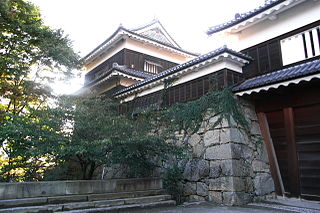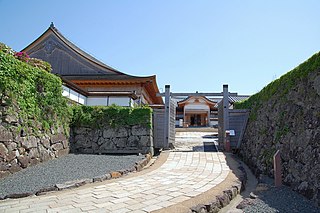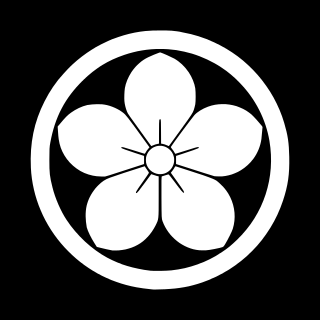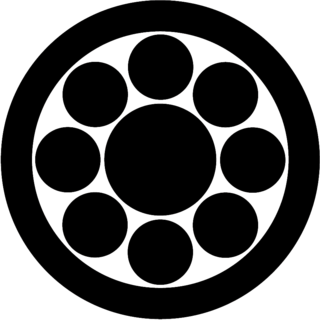Related Research Articles

The Matsudaira clan was a Japanese samurai clan that descended from the Minamoto clan. It originated in and took its name from Matsudaira village, in Mikawa Province. During the Sengoku period, the chieftain of the main line of the Matsudaira clan, Matsudaira Motoyasu became a powerful regional daimyo under Oda Nobunaga and Toyotomi Hideyoshi and changed his name to Tokugawa Ieyasu. He subsequently seized power as the first shōgun of the Tokugawa shogunate which ruled Japan during the Edo period until the Meiji Restoration of 1868. Under the Tokugawa shogunate, many cadet branches of the clan retained the Matsudaira surname, and numerous new branches were formed in the decades after Ieyasu. Some of those branches were also of daimyō status.

The Rokkaku clan was a Japanese samurai clan.

The Sakai clan was a Japanese samurai clan that claimed descent from the Nitta branch of the Minamoto clan, who were in turn descendants of Emperor Seiwa. Serata (Nitta) Arichika, a samurai of the 14th century, was the common ancestor of both the Sakai clan and the Matsudaira clan, which the Sakai later served. In the Sengoku period, under Tokugawa Ieyasu, the Sakai became chief retainers. In the Edo period, because of their longstanding service to the Tokugawa clan, the Sakai were classified as a fudai family, in contrast with the tozama.

The Ogasawara clan was a Japanese samurai clan descended from the Seiwa Genji. The Ogasawara acted as shugo (governors) of Shinano Province during the Sengoku period, and as daimyō of territories on Kyūshū during the Edo period (1600–1867).

Ueda Domain was a feudal domain under the Tokugawa shogunate of Edo period Japan. It is located in Shinano Province, Honshū. The domain was centered at Ueda Castle, located in what is now part of the city of Ueda in Nagano Prefecture.

Matsue Domain was a feudal domain under the Tokugawa shogunate of Edo period Japan, in what is now eastern Shimane Prefecture. It was centered around Matsue Castle and was ruled for most of its history by branch of the Matsudaira clan.

Kakegawa Domain was a feudal domain under the Tokugawa shogunate of Edo period Japan. The domain was centered at Kakegawa Castle in Tōtōmi Province, in what is now the city of Kakegawa, Shizuoka.

Sasayama Domain was a feudal domain under the Tokugawa shogunate of Edo period Japan, located in Tanba Province in what is now the west-central portion of modern-day Hyōgo Prefecture. It was centered initially around Sasayama Castle in what is now the city of Tamba-Sasayama.

Matsushiro Domain was a feudal domain under the Tokugawa shogunate of Edo period Japan. It is located in Shinano Province, Honshū. The domain was centered at Matsushiro Castle, located in what is now part of the city of Nagano in Nagano Prefecture.

The Hizen-Arima clan is a Japanese samurai family. From 1695 until 1871 they ruled the Maruoka Domain as daimyo. They were appointed Viscount after the Meiji Restoration.

The Ōkubo clan were a samurai kin group which rose to prominence in the Sengoku period and the Edo periods. Under the Tokugawa shogunate, the Ōkubo, as hereditary vassals of the Tokugawa clan, were classified as one of the fudai daimyō clans.

The Ōta clan was samurai kin group which rose to prominence in Sengoku and Edo period Japan. Under the Tokugawa shogunate, the Ōta were hereditary vassals of the Tokugawa clan.

Naitō clan is a Japanese samurai kin group. The clan claims its descent from Fujiwara no Hidesato. The Naitō became daimyōs during the Edo period.

The Kyōgoku clan were a Japanese daimyō and samurai clan which rose to prominence during the Sengoku and Edo periods. The clan descend from the Uda Genji through the Sasaki clan. The name derives from the Kyōgoku quarter of Kyoto during the Heian period.
Aoyama Tadao was a daimyō during early-Edo period Japan. His courtesy title was Izumi-no-kami.
Aoyama Tadashige was a daimyō during mid-Edo period Japan.
Ōta Sukekatsu was the 6th daimyō of Kakegawa Domain in Tōtōmi Province, in late-Edo period Japan and 10th hereditary chieftain of the Kakegawa-Ōta clan.

The Sagara clan was a Japanese samurai clan of daimyos. They were a tactical ally of the Shimazu clan.
Sengoku clan was a Japanese samurai family which descended from the Seiwa-Genji.

Tozawa clan was a Japanese samurai kin group from Mutsu and Dewa Provinces who ruled as daimyō of Shinjō Domain under the Edo period Tokugawa shogunate. The Tozawa clan residence in Edo was located near the temple of Zōjō-ji.
References
- 1 2 Papinot, Jacques Edmond Joseph. (1906). Dictionnaire d’histoire et de géographie du Japon; Papinot, (2003). "Aoyama," Nobiliare du Japon, p. 2 [PDF 6 of 80]; retrieved 2013-5-5.
- ↑ Sasayama Castle 篠山城 at Jcastle.info; retrieved 2013-5-5.